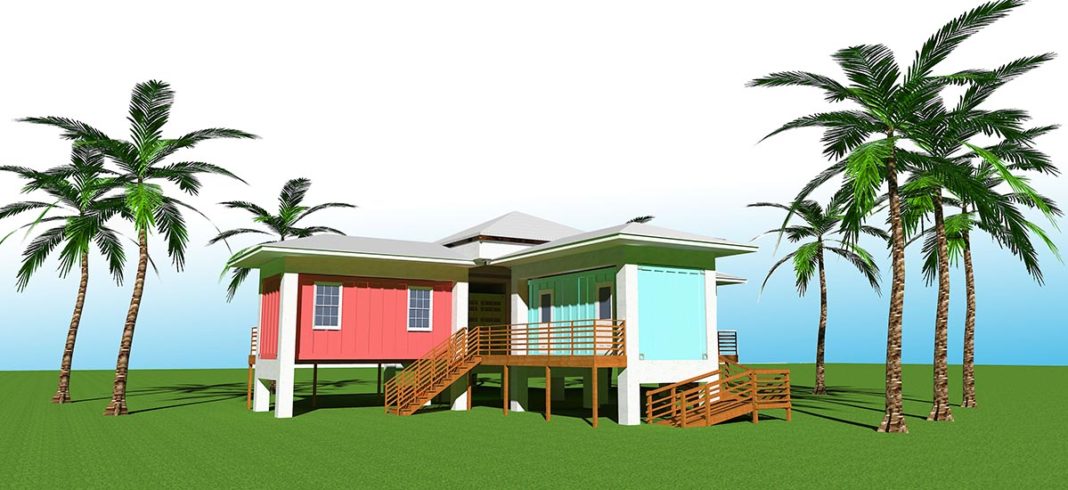The Florida Keys missed out on thousands of volunteer hours after Hurricane Irma hit the Keys. While there were many offers of help, volunteers either had no place to stay as many hotels were offline, or had to arrive fully funded and able to pay the $200-a-night rate. Even in cases where hotels were open, it was hard to balance the need for volunteers with the need to bring the economy back up to speed with tourism dollars.
The plans for the “Volunteer Village” on Big Pine Key could alleviate some of that pressure.
“Really we’re six to nine months too late,” said Monroe County Commissioner George Nugent, “but we’re finally getting it done.”
Monroe County signed a two-year lease with the Monroe County Long Term Recovery Group — at $10 a year — to develop the former site of the Habitat for Humanity Re-Store on Big Pine Key. (The building was leveled after the hurricane, but structural issues closed the store some time ago.)
The plan is to build four pods, capable of housing 12 to 16 volunteers in each. The pods would be raised out of the flood zone, with a free-standing roof to shade the housing. There would be a shared common area, possibly outdoor kitchens, and other facilities to make the facility self-reliant. It would operate like a revolving door — groups would arrive for a week or two to stay and work, to be replaced by a fresh set of volunteers.
Neils Hubbell, a semi-retired builder out of Key West, is helping to draw up the plans that include honest-to-God shipping containers.
“I’ve done a little research and I think I can get a 20-foot shipping container for about $1,800. Basically we divide them in half to create two 10-foot by 10-foot sleeping areas that can accommodate two cots. We cut a hole in one side for the door, and the other side for a window and put an a/c unit on top,” Hubbell said.
The Volunteer Village would be operated by the Monroe County Long Term Recovery Group. Headed by Michelle Luckett, it’s basically an organized leadership group to help coordinate the efforts of nonprofits, faith-based and social service agencies providing disaster assistance in Monroe County.
“We are the point of the spear,” Luckett said of the Monroe County Long Term Recovery Group, “who gets all the help marching in the same direction.” She said her agency can coordinate the efforts of the others — one with funds for roofing supplies and another with volunteer roofers, for example. She said the agency can stand up in a disaster, and possibly go dormant during times when it’s not needed.
So far, she has secured funding for the site’s infrastructure — electric, water and sewer installations — from the Presbyterian Disaster Assistance Network and a Keys nonprofit which chooses to remain anonymous. The Florida Conference of United Methodist Church has pledged $100,000 toward the construction of the first pod. Luckett estimates the entire build will cost about $500,000.
“This would not have been possible without the partnership of Monroe County who leased the land,” said Luckett.
She said the need is long-term: “Realistically, it will take us two more years to recover from Hurricane Irma. And who knows what’s needed after that? Will there be another storm? Or a group of Habitat for Humanity volunteers who need a place to stay while they build affordable housing?” She said the volunteer village could exist in perpetuity and even become a part of the volunteer tourism economy of the Florida Keys. In the event of another storm, it could be used for staging or mobile offices as well.
“The value of a volunteer is so significant,” said Stephanie Kaple, director of the Florida Keys Outreach Coalition. “Keys residents are all working. We may want to go out and volunteer every weekend but other things get in the way — we have jobs, and we’re parents. We need to take advantage of those who have time, and the skills to help us recover while keeping our hotels open for the much-needed tourists.”
The concept of a volunteer village is cutting-edge, but one Neugent said was glaringly obvious even before Hurricane Irma hit. He said the property on Big Pine Key was specifically acquired for the purpose of hurricane recovery many years ago.
“Bill Lowey and I brought this idea forward after Hurricane Wilma in 2005,” Neugent said, “when we knew we at least needed warehouse space.” Neugent said he would like to see a volunteer village on both sides of the 7 Mile Bridge, plus auxiliary sites next to churches or other civic organizations with infrastructure to support trailers for emergency volunteers.























